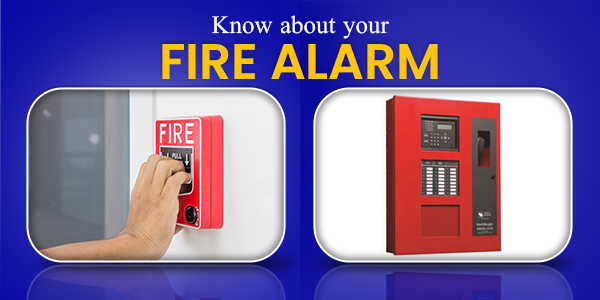
Fire alarms, often referred to as smoke alarms, are an essential component of any building’s safety system. These devices have saved countless lives over the years by providing early warnings in the event of a fire. In this blog, we’ll delve into why fire alarms are so crucial for human safety.
The Crucial Role of Fire Alarms in Ensuring Human Safety:
Early Detection and Warning:
The most critical role of a fire alarm is to provide early detection and warning of a fire. Fires can start small and go unnoticed until they spread rapidly, filling a building with smoke and danger. Fire alarms, equipped with smoke detectors, heat sensors, or both, can detect the earliest signs of a fire, including smoke or an increase in temperature. This early detection allows occupants to evacuate the premises safely before the situation escalates.
Life-Saving Time:
In the event of a fire, every second counts. A fire alarm provides precious minutes for people to escape the building. Without this warning system, individuals may not realize the danger until it’s too late to exit safely. Fire alarms offer the critical time needed to evacuate, potentially preventing injuries and fatalities.
Protection at Night and During Unconsciousness:
Fires can occur at any time, including when people are asleep or otherwise unable to detect the danger. Smoke alarms in homes are particularly vital in such situations. They can wake residents up with a loud, piercing alarm, even when they are in a deep sleep. This ensures that people have a chance to escape from their homes unharmed.
Reducing Property Damage:
While human safety is paramount, fire alarms also play a role in minimizing property damage. Early fire detection allows firefighters to respond more quickly, potentially containing the fire before it spreads extensively. This not only saves lives but also reduces the financial and emotional impact of property loss.
Compliance with Building Codes:
Many building codes and regulations mandate the installation of fire alarm systems in commercial and residential properties. Compliance with these codes is not only a legal requirement but also a moral responsibility to protect occupants’ lives.
Regular Maintenance Matters:
It’s important to note that fire alarms require regular maintenance to ensure they function correctly when needed. Routine testing, battery replacement, and professional inspections are necessary to keep these life-saving devices in working order.
Types of fire alarm systems:
- Conventional Fire Alarm Systems:
- Conventional fire alarm systems divide a building into zones, each with multiple detectors and devices.
- When a detector in a zone is triggered, the system identifies the specific zone but doesn’t provide exact detector information.
- These systems are cost-effective and suitable for smaller buildings with simple layouts.
- Addressable Fire Alarm Systems:
- Addressable fire alarm systems are more advanced than conventional systems.
- Each detector and device in the system has a unique address or identifier.
- When a device is activated, the system not only identifies the zone but also the specific location of the activated device.
- These systems are ideal for larger or complex buildings where pinpointing the source of an alarm is critical.
- Analog Fire Alarm Systems:
- Analog fire alarm systems continuously monitor the status of detectors and devices.
- They provide real-time data on the condition of each device, including smoke detectors and heat sensors.
- Analog systems can be more reliable in detecting fires at an early stage and reducing false alarms.
- Wireless Fire Alarm Systems:
- Wireless fire alarm systems use radio frequency (RF) communication to connect detectors and devices without the need for extensive wiring.
- They are often used in retrofit projects or buildings where wiring is challenging.
- Wireless systems provide flexibility and can be expanded easily.
- Addressable Voice Evacuation Systems:
- Addressable voice evacuation systems combine fire detection with voice announcements and instructions for safe evacuation.
- They are common in large buildings, such as malls and stadiums, where clear communication during emergencies is crucial.
- Aspirating Smoke Detection Systems:
- Aspirating smoke detection systems use a network of pipes and air sampling units to actively sample the air for smoke particles.
- They are highly sensitive and suitable for environments where early detection is essential, such as data centers and museums.
- Flame Detection Systems:
- Flame detection systems are specialized alarms designed to detect the presence of open flames or certain types of fires.
- They are used in industrial settings, where the early detection of specific fire types is critical.
- Beam Smoke Detectors:
- Beam smoke detectors use a transmitter and receiver to create a beam of light.
- When smoke particles disrupt the beam, an alarm is triggered.
- These detectors are often used in large, open spaces such as warehouses.
- Heat Detection Systems:
- Heat detection systems, as the name suggests, trigger an alarm when a predetermined temperature threshold is reached.
- They are used in areas where smoke detectors may result in false alarms, such as kitchens or garages.
Conclusion:
In essence, fire alarms are much more than just devices on the ceiling or wall; they are guardians of human safety. They provide early warnings, save time, and give people the best chance of escaping a fire unharmed. Investing in high-quality fire alarm systems and maintaining them properly is not just a precaution; it’s a commitment to the well-being of everyone in a building. Fire alarms are a testament to our dedication to protecting human lives and property.
**Visit our website at velacctv.com**
